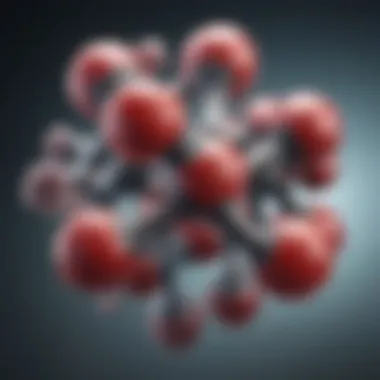Understanding Osimertinib Resistance in Cancer Treatment


Intro
Osimertinib is changing treatment for non-small cell lung cancer with epidermal growth factor receptor mutations. However, understanding its resistance becomes critical for optimizing therapy. This section delves into the intricacies of why patients might not respond effectively to osimertinib, highlighting the broad implications for cancer management.
Research Overview
Methodological Approaches
Research into osimertinib resistance employs various methodologies. These include
- Genomic Sequencing: Identifying mutations in tumor DNA can reveal mechanisms of resistance.
- Cell Line Studies: By testing treatments on specific cancer cell lines, researchers can observe resistance development in controlled environments.
- Clinical Trials: Ongoing studies assess the efficacy of combination therapies, potentially mitigating resistance.
Understanding these approaches is essential. They provide insights that guide future trials and therapeutic strategies.
Significance and Implications
The implications of osimertinib resistance reach beyond individual patients.
- For Patients: Recognizing resistance leads to more effective, personalized treatment plans.
- For Clinicians: Awareness of resistance mechanisms enhances decision-making in therapy selection.
- For Researchers: Understanding resistance drives innovation in drug development, leading to potentially novel solutions.
"Addressing the challenge of resistance not only improves patient outcomes but also paves the way for future therapeutic strategies."
Current Trends in Science
Innovative Techniques and Tools
Recent advancements in science provide tools to combat osimertinib resistance. Technologies such as next-generation sequencing allow for a detailed understanding of genetic mutations within tumors. These innovations also extend to techniques like CRISPR, which can be utilized to study gene function and resistance in real-time.
Interdisciplinary Connections
In the realm of cancer treatment, the significance of interdisciplinary collaboration cannot be overstated. Insights from molecular biology, pharmacology, and bioinformatics converge to create a more comprehensive understanding of osimertinib resistance. These connections enable researchers to interpret resistance mechanisms more effectively, fostering a holistic view of treatment approaches.
In summary, the challenges presented by osimertinib resistance warrant continued investigation and innovation. By employing varied methodologies and embracing interdisciplinary approaches, the quest for effective cancer therapies remains critical.
Prelude to Osimertinib
Osimertinib is an important medication in the fight against non-small cell lung cancer (NSCLC). It specifically targets tumors with mutations in the epidermal growth factor receptor (EGFR). This specificity allows it to effectively inhibit cancer cell growth, making it a preferred choice in many treatment regimens. Understanding this drug is crucial because, while it provides significant benefits, challenges like resistance often undermine its effectiveness.
The discussion of osimertinib is not just about its benefits; it is also about recognizing its limitations. Notably, a growing number of patients develop resistance to osimertinib over time, leading to treatment failure. This phenomenon raises questions about how oncologists can better manage these cases and tailor treatments to individual patients. In this article, we will explore both the mechanisms of action of osimertinib and the clinical applications in a detailed manner to grasp the full implications of its use.
Mechanism of Action
Osimertinib acts as a selective tyrosine kinase inhibitor (TKI). This mechanism is significant as it targets mutant forms of the EGFR. By binding to these mutants, osimertinib prevents downstream signaling pathways that promote tumor cell proliferation and survival. It is particularly effective against the EGFR T790M mutation, which is usually resistant to first-generation TKIs. Therefore, osimertinib has changed the treatment landscape for patients with these specific mutations.
The drug’s selectivity also minimizes damage to normal cells, which aids in reducing side effects commonly associated with cancer treatments. This specificity provides a clearer therapeutic window, improving patient quality of life while targeting the cancer more effectively.
Clinical Applications
Clinical applications of osimertinib are primarily centered on patients with NSCLC harboring sensitive EGFR mutations. It has received approval for both first-line treatments and for patients who have previously been treated with other therapies. One of the notable benefits of osimertinib is its oral administration, allowing for convenient at-home treatment.


In clinical trials, osimertinib has demonstrated considerable efficacy, leading to increased progression-free survival compared to older agents. These results solidified its role in the standard of care for NSCLC, emphasizing the need for molecular testing before initiating treatment.
"Osimertinib has revolutionized the management of EGFR-mutant non-small cell lung cancer, but resistance remains a major hurdle that needs to be addressed."
Overall, understanding osimertinib's mechanism of action and its clinical uses lays the groundwork for delving into the complexities of resistance mechanisms that patients encounter, ultimately shaping future strategies for overcoming these challenges.
Overview of Resistance Mechanisms
The challenge of osimeritinib resistance in cancer therapy is multifaceted. Understanding the resistance mechanisms is crucial for developing effective treatment strategies and for improving patient outcomes. Knowledge of these mechanisms helps clinicians anticipate potential cancer behavior, tailor therapies, and explore combination treatment options. Moreover, grasping the underlying factors can facilitate the design of innovative clinical trials aimed at tackling resistance.
In this article, we will delve into three primary areas of resistance: genetic factors, epigenetic changes, and influences from the tumor microenvironment. Each plays a significant role in how cancer cells adapt to targeted therapies, with varying implications on treatment efficacy.
Genetic Factors
Genetic mutations significantly contribute to osimertinib resistance. One well-known mutation is the EGFR T790M mutation, which can emerge following treatment. This mutation alters the structure of the epidermal growth factor receptor, reducing drug binding ability. It represents a robust example of how genetic changes can render otherwise effective treatments futile.
Additionally, other mutations such as C797S also indicate how cancer cells can evolve. Discovering these mutations often requires comprehensive genomic profiling of the tumors, enabling oncologists to identify and adjust therapies based on the specific genetic landscape of the tumor.
Epigenetic Changes
Beyond genetic mutations, epigenetic modifications also play a pivotal role in osimertinib resistance. These changes involve alterations in gene expression without modifying the underlying DNA sequence. For instance, the methylation of certain genes can silence tumor suppressor genes, leading to unchecked cancer growth.
The complexity of epigenetic modifications is heightened by their reversible nature. This means that therapies targeting these alterations can potentially restore drug sensitivity. Ongoing research is focusing on the interaction between epigenetics and drug resistance, providing an avenue for potentially reversing resistance in affected patients.
Tumor Microenvironment Influences
The tumor microenvironment can significantly influence drug resistance. Cells surrounding the tumor can interact with cancer cells in ways that support survival and growth. For instance, hypoxia within the tumor can lead to modifications in metabolic pathways, enabling cancer cells to thrive despite therapy.
In addition, immune cells and stromal cells in the microenvironment can secrete factors that promote resistance. Understanding these interactions provides insights into how to disrupt the supportive environment that tumors construct through networking cells and signals. Addressing these microenvironmental factors could enhance therapeutic effectiveness and reduce resistance rates.
"Resistance mechanisms are not only genetic; they are influenced by surrounding factors in the tumor's environment and epigenetic modifications."
Key Genetic Mutations Associated with Resistance
Understanding the genetic mutations that contribute to osimertinib resistance is critical. These mutations can significantly impact treatment outcomes in patients with non-small cell lung cancer. It is essential to identify these mutations for reliable prognosis and effective therapeutic strategies.
EGFR T790M Mutation
The EGFR T790M mutation stands out as a key player in osimertinib resistance. Occurring in approximately 50% of patients who develop resistance after initial response to first-line EGFR inhibitors, this mutation presents a considerable challenge. It alters the binding site of the EGFR, leading to reduced efficacy of osimertinib, which specifically targets EGFR with certain alterations.
Notably, the presence of the T790M mutation has been linked with poorer clinical outcomes, making it vital for oncologists and pathologists to test for this alteration. However, patients expressing this mutation might still benefit from second-line treatments, such as afatinib or other more potent inhibitors. Awareness of this mutation can guide therapeutic decisions and provide clarity on the most suitable treatment options.
C797S Mutation
Another significant mutation is the C797S mutation. This mutation is often observed in patients who have already developed resistance via T790M. When C797S occurs, it can hinder the binding of osimertinib altogether. Although less frequent than T790M, its emergence underscores the need for continuous monitoring of genetic changes during treatment.
The presence of C797S mutation can suggest the possibility of switching to alternative therapies or combination treatment regimens. Understanding this mutation aids in refining treatment plans tailored to individual patient profiles.
Other Notable Mutations


Beyond T790M and C797S, several other notable mutations are important in the context of osimertinib resistance. These include:
- L858R mutation: Frequently seen in lung cancer patients, this mutation can contribute to primary resistance.
- G724S mutation: This mutation is less common but can also confer a resistance mechanism, affecting treatment efficacy.
- D761Y mutation: This modification has been linked with both primary and acquired resistance, complicating treatment options further.
These mutations, along with the others mentioned, demonstrate the complexity of genetic factors involved in osimertinib resistance. With ongoing research into these mutations, clinicians can better tailor treatment strategies, thus enhancing patient outcomes in a landscape where resistance is a significant obstacle.
Pharmacological Aspects of Resistance
The pharmacological aspects of resistance play a crucial role in our understanding of osimertinib resistance. These factors not only highlight the complexities of drug interactions but also underscore how variations in dosing can significantly impede the therapeutic efficacy of osimertinib in treating non-small cell lung cancer. Understanding these elements is essential for developing more effective treatment strategies that can potentially overcome or mitigate resistance.
Drug Interactions
Drug interactions can greatly affect the efficacy of osimertinib. When patients are administered multiple medications, there exists a possibility that the pharmacokinetics of osimertinib may be altered. This alteration can occur through enzyme induction or inhibition. The cytochrome P450 system, particularly CYP3A4, is a major pathway involved in the metabolism of osimertinib. Co-administration of drugs that either induce or inhibit this enzyme can lead to significant changes in drug levels within the body.
- Inducers: Medications like rifampicin can increase the metabolic breakdown of osimertinib, potentially rendering the treatment less effective.
- Inhibitors: On the other hand, drugs such as ketoconazole could slow down the metabolism, leading to increased plasma concentrations of osimertinib, which may pose a risk of toxicity.
Patients must be monitored regularly for these potential interactions, and clinicians should be cautious when prescribing multiple therapies. Ensuring optimal drug combinations is key for maintaining the desired therapeutic index.
Dose Limitation Effects
Dose limitation effects refer to the challenges faced when the therapeutic dose of osimertinib must be adjusted due to adverse effects or interactions. High doses of osimertinib can potentially lead to severe side effects such as diarrhea, skin rashes, and liver toxicity. These adverse reactions may necessitate reduction in dosage or interruption of treatment, ultimately paving the way for resistance to develop.
In the context of personalized medicine, adjusting doses based on individual patient response is vital. The therapeutic window must be carefully managed to balance efficacy against safety. Moreover, monitoring biomarkers associated with response to treatment may help guide dose adjustments.
If the patient experiences limitations due to side effects, then the overall treatment strategy may need re-evaluation. This complexity reinforces the importance of individualized approaches tailored to each patient's unique circumstances and treatment history.
"Overcoming pharmacological resistance requires a multifaceted approach that involves understanding drug interactions and optimizing dosage. Each factor plays a pivotal role in the efficacy of osimertinib in clinical settings."
Ultimately, the pharmacological aspects of resistance must not be overlooked, as they provide insight into the mechanisms that lead to treatment failure. By understanding these components, researchers and clinicians can better formulate strategies to combat resistance and improve patient outcomes.
Strategies to Overcome Resistance
The topic of strategies to overcome resistance in cancer treatment with osimertinib is crucial. As resistance mechanisms emerge, treatment efficacy declines, posing an urgent challenge in oncology. Identifying methods to circumvent resistance can enhance patient outcomes significantly. This section outlines various strategies that have been explored and developed to address these issues. Each strategy holds potential benefits, considerations, and implications for treatment plans.
Combination Therapies
Combining osimertinib with other therapeutic agents is a prominent strategy. The goal is to enhance effectiveness by targeting multiple pathways simultaneously. Notably, this approach may prevent or delay the emergence of resistance. For example, clinical studies have investigated the efficacy of combining osimertinib with chemotherapy or other targeted therapies. These combinations can potentially amplify therapeutic effects and leverage the synergistic action of multiple drugs.
Research indicates that combination therapies may lead to improved progression-free survival in patients compared to using osimertinib alone.
Moreover, careful consideration is needed regarding the timing and sequencing of therapies. Using combination therapies may require adjustments to dosing regimens or careful monitoring for side effects. Understanding the pharmacokinetics of each agent is essential. This knowledge helps mitigate risks while maximizing the potential benefits of combination approaches.
Alternative Targeted Therapies
Exploring alternative targeted therapies represents a strategic avenue in overcoming resistance. Following resistance to osimertinib, new therapies can be utilized based on specific mutations that may arise. Novel agents directly targeting resistance mutations are emerging in clinical trials. These options hold promise as they can be tailored to exploit vulnerabilities specific to the resistant cancer cells.
For instance, drugs like almonertinib and nazartinib are in development and focus on addressing particular mutation-induced resistance pathways. As research continues, the expansion of targeted options offers hope for more personalized treatment plans that align with evolving tumor genetics. Thus, integrating alternative targeted therapies could help manage or reverse resistance outcomes effectively.
Immunotherapeutic Approaches


Immunotherapy has transformed cancer treatment paradigms and may provide a strong strategy against osimertinib resistance. By harnessing the body’s immune system to fight cancer, immunotherapies offer a unique mechanism of action that is distinct from traditional targeted therapies. Incorporating immunotherapeutic agents along with osimertinib could potentially counteract resistance mechanisms by engaging immune responses that attack resistant tumor cells.
Investigative studies are examining combinations of osimertinib with immune checkpoint inhibitors or CAR-T cell therapies. These approaches aim to enhance immune recognition and destruction of cancer cells. The potential advantages of immunotherapeutic approaches lie in their ability to adapt to the dynamic nature of tumor biology, potentially overcoming established resistance challenges over time. However, the timing and patient selection for such therapies need careful evaluation to ensure optimal outcomes.
In summary, the development and application of these strategies signify advancing efforts to tackle osimertinib resistance. Combination therapies, alternative targeted therapies, and immunotherapeutic approaches stand at the forefront of ongoing research, offering hope for improved treatment efficacy in non-small cell lung cancer patients.
Current Research and Clinical Trials
The study of osimertinib resistance is a dynamic area of cancer research that holds significant implications for the future of cancer therapy. Current research and clinical trials aim to deepen our understanding of the factors contributing to resistance and to uncover innovative approaches to counteract this challenge. Investigating the nuances of resistance mechanisms not only enhances the efficacy of osimertinib but also promotes better patient outcomes and expands treatment options for the broader lung cancer population. As the landscape of cancer treatment evolves, attention to ongoing research and trial findings is paramount.
Latest Findings
Recent studies have shed light on various dimensions of osimertinib resistance, leading to significant findings. One major focus has been on the emergence of new mutations following treatment. For instance, the identification of additional mutations in the EGFR gene, such as C797S, has been documented. These mutations can alter the binding affinity of osimertinib, making it less effective. Additionally, studies show that the tumor microenvironment plays a critical role in overall treatment efficacy. Factors like hypoxia or the presence of immune cells can influence drug effectiveness and contribute to resistance.
Furthermore, recent clinical trials are exploring combination therapies that merge osimertinib with other targeted agents to enhance efficacy. These combination strategies aim to minimize the likelihood of resistance developing over time. Data from these trials are actively being analyzed to determine the optimal combinations and treatment sequences for various patient demographics.
Innovative Trial Designs
Innovative trial designs are reshaping how researchers approach the study of osimertinib resistance. Adaptive trial designs, for example, allow researchers to modify the study parameters based on interim results. This flexibility enables real-time adjustments to ensure the best outcomes are being explored. Another important trend is the use of basket trials, which assess the effectiveness of osimertinib across different tumor types with similar genetic mutations. Such designs can lead to quicker conclusions about efficacy and expand the clinical applications of osimertinib.
Moreover, the integration of precise biomarkers in trial designs is gaining traction. Personalized medicine approaches target the unique genetic and molecular characteristics of each patient, tailoring treatment strategies accordingly. This not only enhances the relevance of findings but also addresses the challenge posed by heterogeneity in tumor responses.
"The evolution of trial designs represents a critical shift towards a more nuanced understanding of resistance mechanisms and therapy optimization."
In summary, the current research landscape surrounding osimertinib resistance is rich with insights and evolving methodologies. Ongoing trials are not just about overcoming resistance but also about enhancing the understanding of lung cancer pathophysiology. Continued commitment to these efforts will ultimately pave the way for more effective treatment strategies and better patient care.
Future Directions in Osimertinib Resistance Research
Osimertinib, while a groundbreaking advancement in targeted therapy, faces significant challenges due to resistance. Addressing this resistance is crucial for improving patient outcomes. Future directions in research must focus on understanding the underlying mechanisms of resistance and developing innovative strategies to combat it. This research is vital not only for enhancing the effectiveness of osimertinib but also for ensuring that treatment is tailored to the individual patient's needs.
Personalized Medicine Approaches
Personalized medicine tailors treatment to each patient's unique genetic makeup, lifestyle, and environment. As it relates to osimertinib, adopting personalized medicine approaches may provide significant benefits. By identifying specific genetic mutations within tumors, oncologists can adjust treatment strategies. Genetic profiling might reveal whether a patient will benefit from osimertinib or if alternative therapies should be considered.
Additionally, personalizing therapy may also involve pharmacogenomics. This studies how genes affect a person's response to drugs. Understanding how different patients metabolize osimertinib could optimize dosing and reduce resistance. For instance, some individuals may require higher doses due to faster metabolism, while others may develop toxicity at standard doses.
Utilization of Biomarkers
Biomarkers hold considerable potential in addressing osimertinib resistance. Utilizing biomarkers allows for the identification of patients who exhibit resistance or are at high risk of developing it. Key biomarkers can guide clinicians in deciding the best course of action. For example, liquid biopsies may detect circulating tumor DNA, indicating changes that confer resistance, such as mutations in the EGFR or other relevant genes.
Furthermore, the integration of biomarkers into clinical practice can facilitate monitoring treatment response over time. This real-time feedback enables timely adjustments to therapy, which is essential in managing resistance. The identification and validation of reliable biomarkers could facilitate the development of novel treatment strategies and combination therapies to enhance efficacy.
"The future of osimertinib resistance research centers on exploiting personalized approaches and leveraging biomarkers to tailor therapies to individual patients, which may ultimately revolutionize cancer treatment."
Culmination
Osimertinib has transformed the landscape of targeted therapy for non-small cell lung cancer, specifically in cases with epidermal growth factor receptor mutations. However, the emergence of resistance to osimertinib is a pressing issue that can severely undermine treatment efficacy. Understanding this resistance is crucial for several reasons.
First, knowledge of resistance mechanisms empowers clinicians to develop more effective treatment strategies. Recognizing the genetic and environmental factors contributing to resistance enables better patient management. Clinicians can tailor treatments based on individual patient profiles, which is especially important in oncology where a one-size-fits-all approach often fails.
Second, ongoing research into osimertinib resistance is essential to uncover innovative solutions. Studies focused on genetic mutations, pharmacological interactions, and tumor microenvironments continuously evolve. These efforts provide insights that could lead to the development of new drugs or combination therapies that could outsmart resistant cancer cells.
Additionally, the exploration of personalized medicine approaches, utilizing specific biomarkers, plays a critical role in future treatment paradigms. Personalized therapies can help in identifying patients most likely to respond to osimertinib or other new therapies, thereby enhancing the probability of positive outcomes.
The significance of addressing osimertinib resistance cannot be overstated; it is integral to optimizing cancer management and improving survival rates.



